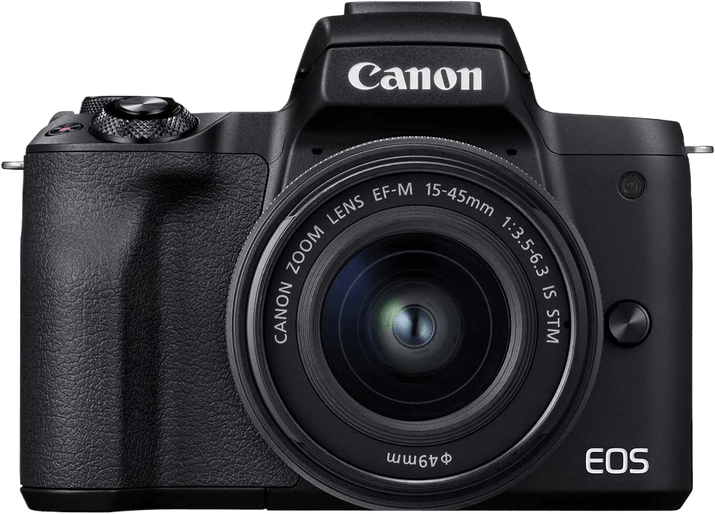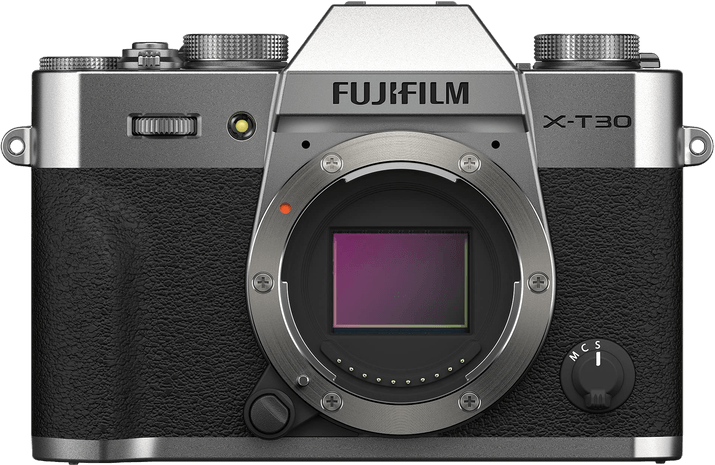Canon EOS M50 Mark II vs Fujifilm X-T30 II Comparison
Canon EOS M50 Mark II

Fujifilm X-T30 II

The Fujifilm X-T30 II emerges as the winner with a score of 65/100, while the Canon EOS M50 Mark II trails behind with a score of 59/100. Both cameras are mirrorless and were released in 2020 and 2021, respectively. They share similar dimensions and weight, with the Fujifilm X-T30 II measuring 118 x 83 x 47mm and weighing 383g, while the Canon EOS M50 Mark II measures 116 x 88 x 59mm and weighs 387g.
The Fujifilm X-T30 II’s higher score signifies its better performance and features compared to the Canon EOS M50 Mark II. However, the Canon EOS M50 Mark II has an advantage in terms of price, being more affordable at $750 compared to the Fujifilm’s $899 launch price.
Taking these factors into account, the Fujifilm X-T30 II offers better performance and features, making it a more desirable option for those who value quality over cost. On the other hand, the Canon EOS M50 Mark II is a more budget-friendly choice for those looking for a capable mirrorless camera without breaking the bank.
Canon EOS M50 Mark II vs Fujifilm X-T30 II Overview and Optics
The Fujifilm X-T30 II comes out on top in the optics comparison with a score of 67/100, while the Canon EOS M50 Mark II scores 59/100. Both cameras share several specifications, such as having APS-C CMOS sensors, no image stabilisation, and similar lens mounts (Canon EF-M for the M50 Mark II and Fujifilm X for the X-T30 II).
The Fujifilm X-T30 II has a higher megapixel count at 26 compared to the Canon’s 24, which results in better image resolution. Additionally, the X-T30 II boasts a remarkable shooting speed of 30, significantly outperforming the M50 Mark II’s shooting speed of 10. The Fujifilm’s X-Processor 4 also contributes to improved image processing and overall performance.
On the other hand, the Canon EOS M50 Mark II has a DXOMARK score of 58 for its sensor. Unfortunately, we cannot compare this score to the Fujifilm X-T30 II, as DXOMARK does not score Fujifilm cameras. However, this score can still be taken as an indicator of the M50 Mark II’s sensor performance.
In conclusion, the Fujifilm X-T30 II holds an advantage in optics with its higher megapixel count and impressive shooting speed. The Canon EOS M50 Mark II, while not able to outperform the Fujifilm in these categories, still offers a respectable DXOMARK score for its sensor. As a result, the Fujifilm X-T30 II emerges as the winner in this optics comparison, making it a more suitable option for photographers seeking higher resolution and faster shooting capabilities.
Canon EOS M50 Mark II vs Fujifilm X-T30 II Video Performance
The Canon EOS M50 Mark II and the Fujifilm X-T30 II both have a video score of 91 out of 100, indicating that they offer comparable video capabilities. Both cameras share key video specifications, including 4K video resolution and a maximum video frame rate of 120fps. Additionally, both cameras come with built-in time-lapse functionality.
The Canon EOS M50 Mark II has a maximum video dimension of 3840 x 2160, which is slightly lower than the Fujifilm X-T30 II’s 4096 x 2160. This difference in video dimensions means that the Fujifilm X-T30 II provides a slightly wider aspect ratio, resulting in more cinematic footage. However, this advantage is relatively minor and might not be noticeable for most users.
On the other hand, the Canon EOS M50 Mark II does not have any distinct advantages over the Fujifilm X-T30 II in terms of video capabilities. Both cameras perform equally well in this aspect, and users can expect similar video quality from them.
In comparing the video capabilities of the Canon EOS M50 Mark II and the Fujifilm X-T30 II, it is clear that both cameras offer similar performance. The Fujifilm X-T30 II has a slight edge in terms of video dimensions, but this advantage is minor and may not be significant for most users. Ultimately, the choice between these two cameras should be based on other factors, such as price, design, and personal preference, as their video capabilities are nearly identical.
Canon EOS M50 Mark II vs Fujifilm X-T30 II Features and Benefits
The Canon EOS M50 Mark II and the Fujifilm X-T30 II both have a feature score of 70/100, making them equal in terms of overall features. They share several specifications, including a 3-inch screen size, 1040000-dot screen resolution, touchscreen capability, flip screen, and the absence of GPS. Both cameras also offer WIFI and Bluetooth connectivity.
Despite the equal scores, the Canon EOS M50 Mark II has some advantages. Its user interface is more beginner-friendly, making it a better choice for those new to photography. The camera also has a more extensive lens selection, providing photographers with more options for various shooting scenarios.
On the other hand, the Fujifilm X-T30 II excels in its image quality and color reproduction. It is known for its unique film simulation modes, allowing users to achieve a distinct look in their images. Additionally, the X-T30 II has a faster autofocus system, ensuring sharp images even in fast-paced shooting environments.
When comparing the two cameras, it is essential to consider individual needs and preferences. The Canon EOS M50 Mark II is better suited for beginners and those who prioritize a more extensive lens selection. Meanwhile, the Fujifilm X-T30 II is the better option for photographers who value image quality, color reproduction, and a faster autofocus system.
Both cameras have their strengths and weaknesses; thus, the final decision depends on the specific requirements and priorities of the photographer.
Canon EOS M50 Mark II vs Fujifilm X-T30 II Storage and Battery
The Fujifilm X-T30 II outperforms the Canon EOS M50 Mark II in storage and battery with a score of 35/100, compared to Canon’s 21/100. Both cameras have one memory card slot and accept SD, SDHC, and SDXC (UHS-I compatible) cards. However, the Fujifilm X-T30 II offers a longer battery life of 380 shots compared to the Canon EOS M50 Mark II’s 305 shots. Additionally, the Fujifilm X-T30 II uses the NP-W126S battery and supports USB charging, making it more convenient for on-the-go users.
The Canon EOS M50 Mark II uses the LP-E12 battery and lacks USB charging capabilities, which is a disadvantage compared to the Fujifilm X-T30 II. Despite this, both cameras still offer sufficient storage options and acceptable battery life for casual photography.
Considering the storage and battery aspects, the Fujifilm X-T30 II proves to be the better choice for photographers who prioritize longer battery life and convenient charging options. While the Canon EOS M50 Mark II falls short in this comparison, it may still be suitable for those who do not require extensive battery life or USB charging.
Canon EOS M50 Mark II vs Fujifilm X-T30 II – Our Verdict
Are you still undecided about which camera is right for you? Have a look at these popular comparisons that feature the Canon EOS M50 Mark II or the Fujifilm X-T30 II:

